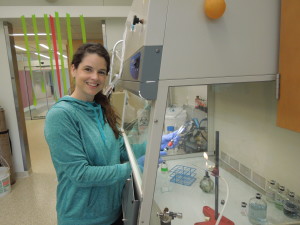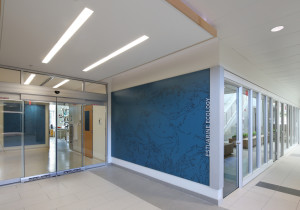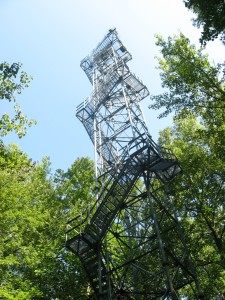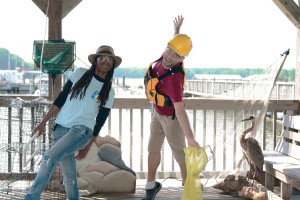by Kristen Minogue and Heather Soulen
May 12 is Limerick Day, which among science aficionados is a time to wax poetic about the joys of research. Or not. When you’re an ecologist, sometimes research is muddy, smelly, or just plain weird. Electric skillets and marbles can become safety features. But then, the thrill of climbing a 120-foot tour can remind you why it’s all worthwhile.
While some limericists adhere rigidly to the anapestic meter, the one thing all limericks have in common is the familiar A-A-B-B-A rhyme scheme. So enjoy a few snapshots in verse about the lesser-known side of environmental science:

Ally Soren, Microbial Ecology Lab technician. (SERC)
The Sweet Smell of Science
Are those cow guts that make the lab stench?
Fatty acids make my stomach clench.
They smell like fish and feet
But the microbes must eat,
While my lab mates avoid my work bench.
The inspiration for this limerick came from Ally Soren, a technician in SERC’s Microbial Ecology Lab. Scientists in the microbial lab cultivate several different types of wetland microbes, to study how they transform mercury into the neurotoxin methylmercury. Unfortunately, those microbes feed on some very nasty substances—like rumen fluid, pulled straight from a cow’s gut, and fatty acids which, in Soren’s words, smell like “fish, farts and feet.” “People walk by my lab with a look of sheer disgust,” she says. Thankfully there is a purge button in the lab, which sucks all the air out of the room when they’re finished.

Entrance to the Estuarine Ecology Guild of the Mathias Lab.
Living in a Green Lab
To make the LEED-Platinum class
We put geothermal wells ‘neath the grass.
Natural lighting, we knew
Would cut our CO2.
But our office doors are made of glass.
In 2014, SERC finished building the Charles McC. Mathias Lab—the first Smithsonian building to make LEED-Platinum, the highest ranking a building can earn from the U.S. Green Building Council. Solar panels, a geothermal well field, and the ability to recycle virtually all of its water all helped push the lab into the upper ranks. However, the design, which allows the building to be lit naturally by sunlight, meant the office doors had to be made of glass!

SERC Weather Tower
Stairway to Solar Science
Our meteorological tower
Records the sun’s UV power
Its bird’s eye view
And calibration true
Capture spectral data each hour.
SERC’s 120-foot weather tower captures all kinds of data, on temperature, wind speed and the chemicals that come down in rain. But its original purpose when it was set up in 1996 was to capture the sun’s ultraviolet (UV) radiation, the rays responsible for sunburns and skin cancer, but which also help us synthesize Vitamin D. The instruments on the tower keep track of spectral UV, which can divide the UV into UV-A radiation and the more harmful kind, UV-B. Overall the Smithsonian Institution has been tracking UV since 1975, when its UV detectors were set up in Rockville, Md. SERC’s Photobiology Lab took the experiment over in 1996, when the Institution moved it to SERC’s weather tower. The instruments take UV-B averages every 12 minutes, and SERC’s database includes records for Maryland all the way back to 1975.
Acid Cleaning
Before sample digestion
And mercury assessin’
An electric skillet
Has great merit
In preventing contamination.
Another limerick inspired from SERC’s Microbial Ecology Lab: Before scientists can analyze a sample for total mercury, the team must acid clean their glassware to remove all trace amounts of mercury. This process requires glass Erlenmeyer flasks, a combination of nitric and sulfuric acids, marbles (white round things on top of each flask), heat and time. However, expensive laboratory grade heating elements are often ruined from acid used during cleaning and sample prep process. So, to heat the acid concoction in each flask, the lab came up with a simpler solution: electric skillets!
And we can’t forget the SERC Open House, running rain or shine on Saturday, May 14! In the spirit of this year’s theme, “Conserving Ecosystems: Where Do You Fit In?” here are couple short limerick-style previews of what awaits:

Scientists get wild at the Open House photo pavilion. (SERC)
It’s a Challenge
Where do you fit in?
Where do we begin?
While tough to measure
Humans and nature
Could be worth explorin.’
Visit Our Photo Booth
Waders and a snorkel
Clipboards and a pencil
With just a click
We’ll take your pic
And a scientist you’ll resemble.

